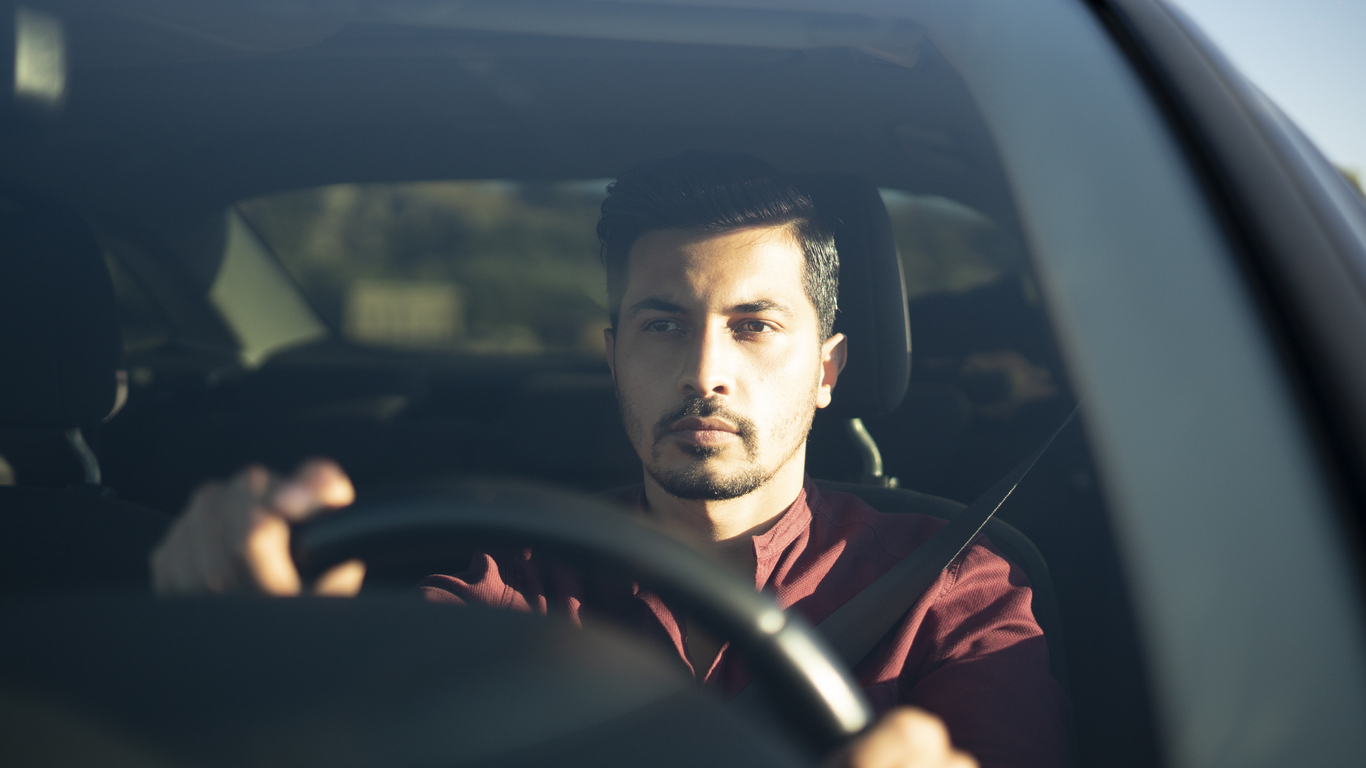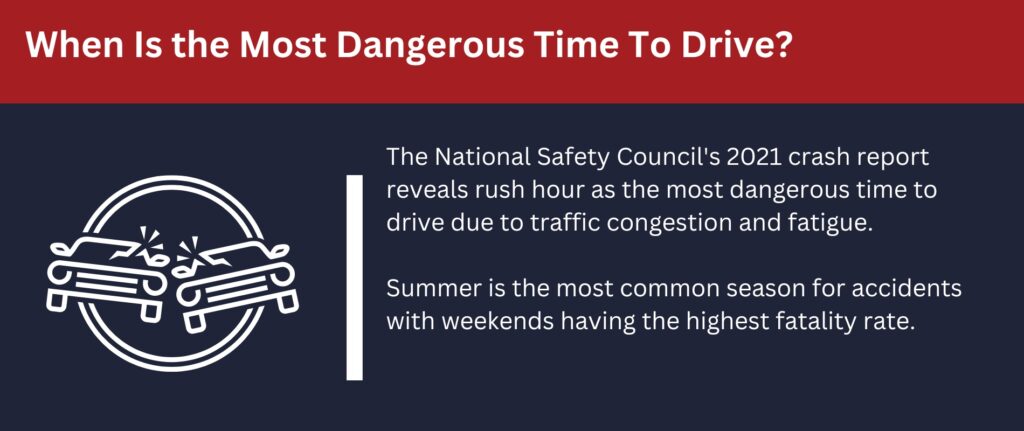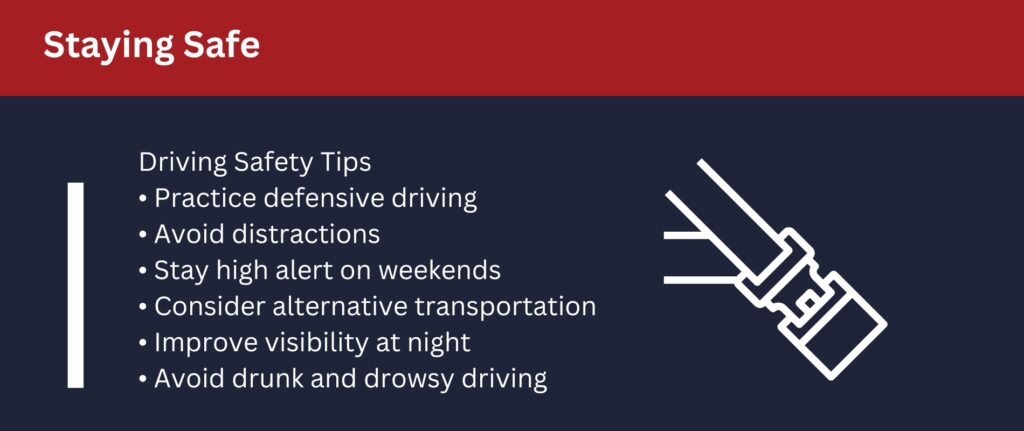
According to the National Safety Council (NSC) Injury Facts 2021 crash report analysis, the most dangerous time to drive is the rush hour (between 4 p.m. and 7:59 p.m.) During this time, traffic is congested as people get off work. They’re also more often tired during this time of the day, increasing the rate of drowsy driving-related accidents.
However, the peak time for accidents may vary throughout the year based on the season, day of the week, and time of day. Most accidents happen during summer as more people venture outdoors to enjoy the great weather. Weekends also record the highest number of fatal crashes, mostly due to the increased number of intoxicated drivers on the roads.
Accidents are also more prone to happen when it’s dark. Peripheral vision and depth perception are compromised in the dark, increasing the risk. On weekends, midnight to 4 a.m. are the deadliest hours to drive, with more drunk drivers on the roads.
Holidays are also riskier periods to drive than other times of the year. The most dangerous holidays include Christmas to New Year, Thanksgiving, Memorial Day, Labor Day, and the Fourth of July. Some reasons for increased crashes during holidays include traffic congestion, drunk driving, and fatigue.
To help you stay safe on the road, we’ve gone into an in-depth breakdown of the most dangerous times to drive below.
The Most Dangerous Time of Day
When is the most dangerous time to drive?
According to recent crash reports from the NSC, 4 p.m. to 7:59 p.m. is the deadliest time of day to drive. The second most dangerous time was between 8 p.m. and 11:59 p.m., while noon to 3:59 p.m. had the third highest number of fatal crashes.
However, dangerous times of the day vary widely, depending on the season. For instance, from 4 p.m. to 7:59 p.m. fatal crashes peaked during November through March. During spring and summer, fatal crashes increased between 8 p.m. and 11:59 p.m. Summer also recorded an increase in non-fatal crashes between noon and 3:59 p.m.

During rush hour (4 p.m. and 7:59 p.m.), you expect most drivers to be exhausted from work; hence, drowsy driving is a highly probable cause of accidents. Similarly, the increased number of fatal crashes between 8 p.m. and 12 midnight may largely be caused by poor visibility – as the glare of headlights from oncoming vehicles and shadows of the night compromise clear visibility.
What Is the Most Dangerous Day to Drive?
The weekend is the most dangerous time to drive, with Saturday being the peak. People are mostly out drinking and partying during the weekend, increasing the risk of crashes caused by intoxicated drivers. People are also most likely to be fatigued from the week’s activities on Saturdays and Sundays. Drowsy driving impairs one’s judgment and is responsible for a projected 328,000 accidents per year.
Fatal crashes are also prevalent during weekdays, especially during rush hour as people leave work. In 2021, the average daily traffic deaths were 116. Saturdays were the most dangerous days, followed by Friday, then Sunday. Saturday, August 7th, was the deadliest day in the year, with 201 deaths.
Which Month Is Most Deadly?
According to the NSC, summer and fall have the highest vehicle miles traveled, as more people go out to enjoy the warm weather. During these seasons, fatal crashes increase accordingly. During winter, particularly January and February, the least amount of road crash fatalities occur. This makes sense given fewer people venture out at this time, except from Christmas through New Year.
Usually, fatal crashes start picking up in March through October and then drop up to February. In 2021, October was the deadliest month with 4,101 fatalities, followed by August, then July. February and January had the least fatalities at 2,561 and 3,099, respectively.
Staying Safe

Car accidents can happen anytime, irrespective of the time of day, day of the week, or month. However, knowing the most dangerous times to drive will help you stay alert or avoid driving during those times altogether. Here are some tips to keep you safe:
- Practice defensive driving: Prioritize your safety by being more aware of your surroundings while driving. Do not depend on other drivers for your safety or assume they will grant your right of way. For instance, if a driver is driving aggressively, slow down, be patient, and pull over if you have to.
- Avoid distractions: Minimize distractions while driving, like using your phone, fidgeting with the radio, or indulging in heated conversations with a passenger.
- Be on high alert on weekends: Stay alert on weekends. The likelihood of fatigued and intoxicated drivers on the roads is higher during the weekend; hence, stay safe by practicing defensive driving.
- Consider alternative transportation: Consider using other means of transportation if possible, especially during dangerous times and seasons.
- Improve your visibility when driving at night: If you must drive at night and you have compromised night vision, install headlamps designed for better illumination and use high beams when no cars are approaching.
- Avoid drunk and drowsy driving: Intoxication and fatigue impair one’s judgment. Avoid going behind the wheel whenever you feel fatigued or after drinking, as these can compromise your alertness.
If you’re injured after a car accident, make sure to see a doctor.
Were you in an accident?
Now that you know the most dangerous times to drive, focus on keeping yourself safe.
Meanwhile, if you’ve been in an accident, reach out to one of our experienced car accident lawyers to assist you in obtaining the compensation you deserve for any damages sustained.
Among other things, an attorney can help you gather evidence and develop a strong case, calculate damages, file a claim negotiate with insurance companies, or represent you in court (should the case go to trial). Contact our legal team today or call us 24/7 at (800) 718-4658 for a free case evaluation.

